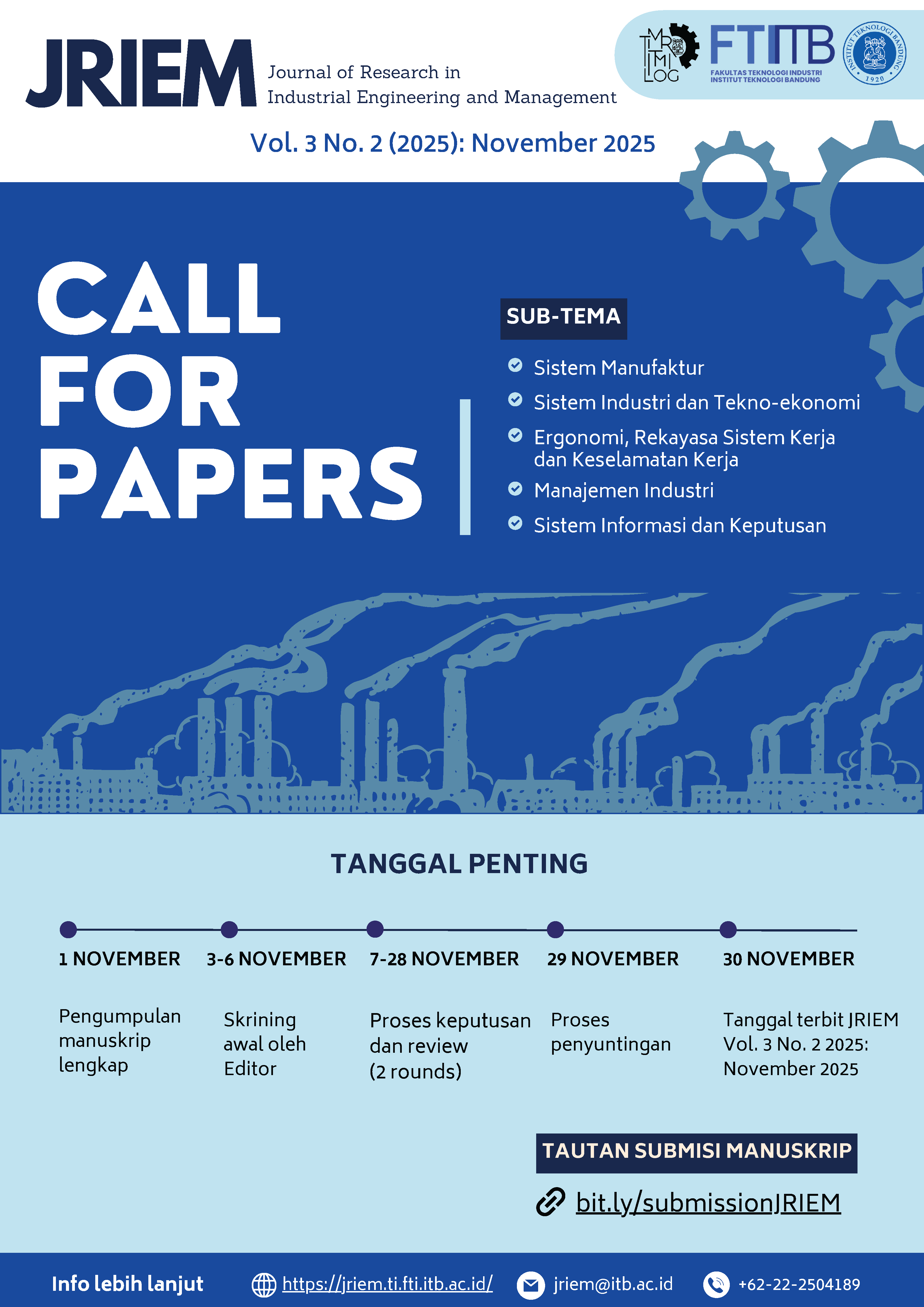Evaluation of Student Mental Workload in Multicampus Lectures of Cirebon Industrial Engineering Block System
DOI:
https://doi.org/10.61221/jriem.v2i1.18Kata Kunci:
mental workload, KSS, block system, Stroop test, NASA-TLXAbstrak
The object of this research is the Industrial Engineering (IE) study program at Bandung Institute of Technology Cirebon Campus which runs block and non-block system lecture. The block system is a lecture by combining two to three class meeting of a course in one day while non-block system is a one time meeting in a week. Block system faced a lot of complained from students because the class were too hectic, the inability of students to receive a lot of quantitative material, and the monotony of the class. This study evaluates student’s mental workload by comparing the results of experimental measurements while attending block and non-block classes. Mental workload was measured with three measuring instruments, named NASA-TLX, Karolinska Sleepiness Scale (KSS), and Stroop test. Experimental results with 38 students concluded that there is actually no significant difference in mental workload between the two systems. Factors that could cause this results to happen include previous experience in block classes, non-optimal block system instructional learning time, mental fatigue in students, and decreased attention.
Referensi
Akerstedt, T., & Gillberg, M. (1990). Subjective and Objective Sleepiness in the Active Individual. Intern. J Neuroscience, 52(2), 29-37.
Barwick, F., Arnett, P., & Slobornouv, P. (2012). EEG correlates of fatigue during the administration of a neuropsychological test battery. Clinical Neurophysiology, 123(2), 278-284.
Bowyer, K. (2012). A Model of Student Workload. Journal of Higher Education Policy and Management, 34(3), 239-258.
Ghasemi, A., & Zahedials, S. (2012). Normality tests for statistical analysis: A guide for non-statisticians. International Journal of Endocrinology and Metabolism, 10(2),486-489.
Groenwald, S. (2018). The challenges and opportunities in leading a multi-campus university. Journal of Professional Nursing, 2(34), 134-141.
Habibah, S., Putra, Y., & Putri, Y. (2019). Faktor-faktor yang mempengaruhi angka partisipasi perguruan tinggi pada 32 provinsi di Indonesia tahun 2013-2016. Jurnal Anggaran dan Keuangan Negara Indonesia, 1(1), 16-33.
Hoddes, E., & Zarcone, V. (1973). Quantification of sleepiness: a new approach. Psychophysiology, 10(4), 431-436.
Homack, S., & Riccio, C. (2004). A meta-analysis of the sensitivity and specificity of the Stroop Color and Word Test with children. Archives of Clinical Neuropsychology, 19(6), 725-743.
Hosteng, K., & Reicher, A. (2019). Uninterrupted Classroom Sitting is Associated with Increased Discomfort and Sleepiness Among College Students. International Journal of Environmental Research and Public Health, 16(4), 1-10.
Johnson, A., & Widyanti, A. (2011). Cultural influences on the measurement of subjective mental workload," Ergonomics, 54(6), 509-518.
Kaida, K. (2006). Validation of the Karolinska sleepiness scale against performance and EEG variables. Clinical Neurophysiology, 1574-1581.
Kyndt, E., Berhgman, I., & Buckens, L. (2014). Time is not Enough.’ Workload in Higher Education: A Student Perspective. Higher Education Research & Development, 33(4), 684-698.
Labak, I., & Radanovic, I. (2020). Effects of block vs. Traditional scheduling on high school science success—lessons from biology classes. Education Sciences, 10(1),1-19.
Liesefeld, H., & Janzcyk, M. (2019). Combining speed and accuracy to control for speed-accuracy trade-offs(?). Behavior Research Methods, 51(1), 40-60.
Linman, C., & Andersson, H. (2006). The Stroop effect on the internet. Computers in Human Behavior, 22(3), 448-455.
Morales, A., Arellano, J., & Munoz, E. (2020). Development of the NASA-TLX Multi Equation Tool to Assess Workload. International Journal of Combinatorial Optimization Problems and Informatics, 11(1), 50-58.
Moroney, W., Biers, D., & Eggmeier, F. (1992). A Comparison of Two Scoring Procedures with the NASA Task Load Index in A Simulated Flight Task. National Aerospace and Electronics, 2, 734-740.
Morris, R. (2022). Block Scheduling and Its Gift of Time: a Comprehensive Review. Educational Planning, 20(2), 61.
Mosteanu, N. (2021). Teaching and Learning Techniques for the Online Environment. How to Maintain Students’ Attention and Achieve Learning Outcomes in a Virtual Environment Using New Technology. International Journal of Innovative Research and Scientific Studies, 4(4), 278-290.
Nicolson, R. (2004). The management of multicampus systems. South African Journal of Higher Education, 18(2), 346-358.
Okano, K., & Kaxzmarzyk, J. (2019). Sleep quality, duration, and consistency are associated with better academic performance in college students. Science of Learning, 4(1), 1-5.
Randler, C., & Konstanze, K. (2008). Block scheduled versus traditional biology teaching—an educational experiment using the water lily. Instructional Science, 36(1), 17-26.
Ratchfliff, N., & Pritchcard. (2014). The Interaction of School Organization and Classroom Dynamics: Factors Impacting Student Achievement. Journal of Research in Education, 24(2), 3-17.
Reteig, L. (2019). Sustaining attention for a prolonged period increases temporal variability in cortical responses. Cortex, 117, 16-32.
Said, S., & Gozdzik, M. (2020). Validation of the raw national aeronautics and space administration task load index (NASA-TLX) questionnaire to assess perceived workload in patient monitoring tasks: Pooled analysis study using mixed models. Journal of Medical Internet Research, 22(9).
Virtanen, K., Mansikka, H., & Harris, D. (2022). Weight watchers: NASA-TLX weights revisited. Theoretical Issues in Ergonomics Science, 23(6), 725-748.
Wedel, K., & Freundl, V. (2022). How Does Instruction Time Affect Student Achievement? The Moderation Role of Teacher Qualifications. CESifo Forum, 23(3), 33-39.
Xiao, Y., & Ma, F. (2015).Sustained Attention is Associated with Error Processing Impairment: Evidence from Mental Fatigue Study in Four-Choice Reaction Time Task. PLoS ONE, 10(3), 1-15.
Unduhan
Diterbitkan
Cara Mengutip
Terbitan
Bagian
Lisensi
Hak Cipta (c) 2024 Yudisiasita Muslim, Ari Widyanti

Artikel ini berlisensi Creative Commons Attribution 4.0 International License.




